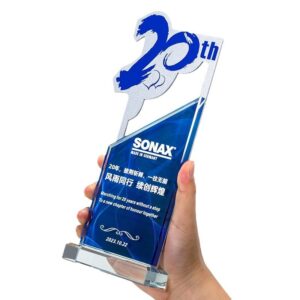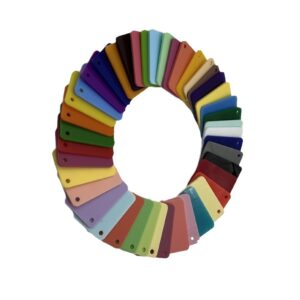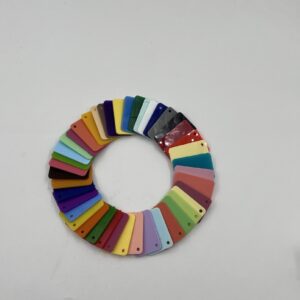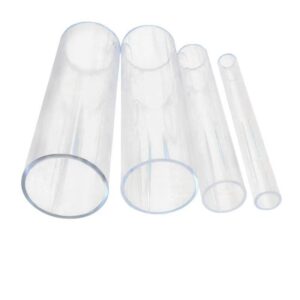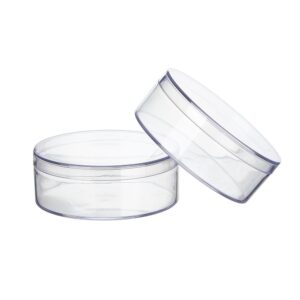Acrylic keychains don’t just tag along—they tell your story in the split second before a door clicks open. With the right material, print stack, and hardware, these tiny canvases become pocket-size ambassadors for your brand.
Inhoudsopgave
Acrylic keychain material properties: clarity, hardness, thickness
Start with PMMA for its glass-like clarity and everyday toughness. Cast acrylic offers superior optical quality and crisp engraving; extruded acrylic provides tight thickness control for large runs. Most designs live comfortably between 2–4 mm: slim enough for EDC comfort, thick enough to shrug off scuffs. If you’re planning color-critical art or frosted engraves, sample both materials using custom acrylic sheets before you lock specs.
Edge finishing techniques that elevate quality
Laser cutting yields glossy, gemstone-like edges. Flame polishing amplifies that shine; a light bevel or chamfer masks micro-scratches and improves hand feel. Rounded outer corners reduce chip initiation during drops.

Laser cutting and UV printing: the modern customization stack
Today’s go-to stack is simple and reliable: laser cutting for silhouette accuracy, UV printing for full-color art, and laser engraving for permanent detail. Reverse-printing on the back face of a clear piece protects pigments while adding optical depth. If your campaign needs a premium unboxing, stage sets in slim acryldozen op maat to boost perceived value.
Double-sided artwork vs. single-sided printing
Single-sided prints are straightforward but expose ink to abrasion. Double-sided builds sandwich color beneath a clear layer and often include a selective white underprint for punch. For characters or badges, mirror the back art to align perfectly with the front.
Shapes, charms, and hardware: designing the full experience
A great keychain balances silhouette, movement, and attachment. Split rings keep things classic; lobster or swivel clasps make bag-clip use effortless and reduce tangles. Add mini-charms for motion or a soft tassel for texture. For countertop sell-through, present bundles on modular custom acrylic displays that match your brand’s palette.
Functional add-ons that add real utility
QR codes link fans to care pages, drops, or loyalty perks. Serialized engraving supports limited editions. If you’re building VIP access or warranties, tuck a thin NFC tag behind the art. For photo consistency, style shoots on clean acrylschalen op maat.

Durability engineering: artwork placement, coatings, and testing
Treat durability as a design requirement. Place dense ink away from hole lands and outer edges; specify a UV-cured clearcoat (≥2H pencil hardness) over exposed prints; and run a “pocket test” with keys and coins for a week. If you plan extensive engraving, prototype contrast and surface haze first—then align your process with the shop notes in acrylproductie.
Common field failure modes to prevent
- Abrasion on exposed prints and edges
- UV fade or yellowing in clear zones
- Stress cracks around the ring hole from tight hardware
- Delamination due to poor ink adhesion or over-inked edges

Visual effects and finishing: from spot white to frosted engraves
Spot white keeps colors vivid on clear acrylic; selective matte varnish tames fingerprints; subtle glitter or iridescence can create “pick-me-up” moments—use sparingly to stay on-brand. If you want trophy-like presence for collector drops, borrow cues from custom acrylic trophies and awards: beveled edges, crystal-clear faces, and precise engraving.

Brand storytelling in small format: retail, events, and kits
Acrylic keychains thrive where identity meets impulse—artist alleys, museum shops, esports merch, book launches, trade-show kits. Support wayfinding at booths or pop-ups with clean aangepaste acryl signs so the story carries from display to checkout.
Production workflow: from dieline to delivery
Move in a straight line—concept, dieline, prototype, test, production—so every box you ship matches the sample everyone approved.
- Draft the dieline (shape, kerf allowance, ring-hole spec) using the step-by-step guidance in how to customize.
- Validate materials, edge finishes, and polish on a small pilot before committing.
- Confirm color under consistent lighting; retain a master sample for reorders.
- If your campaign spans stands, trays, and signage, source from the same family (sheets, rods, tubes) to keep clarity and tint consistent—see custom acrylic rods and tubes.
- Explore the full range from the homepage to keep accessories cohesive across touchpoints.



